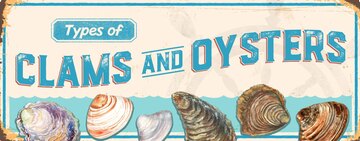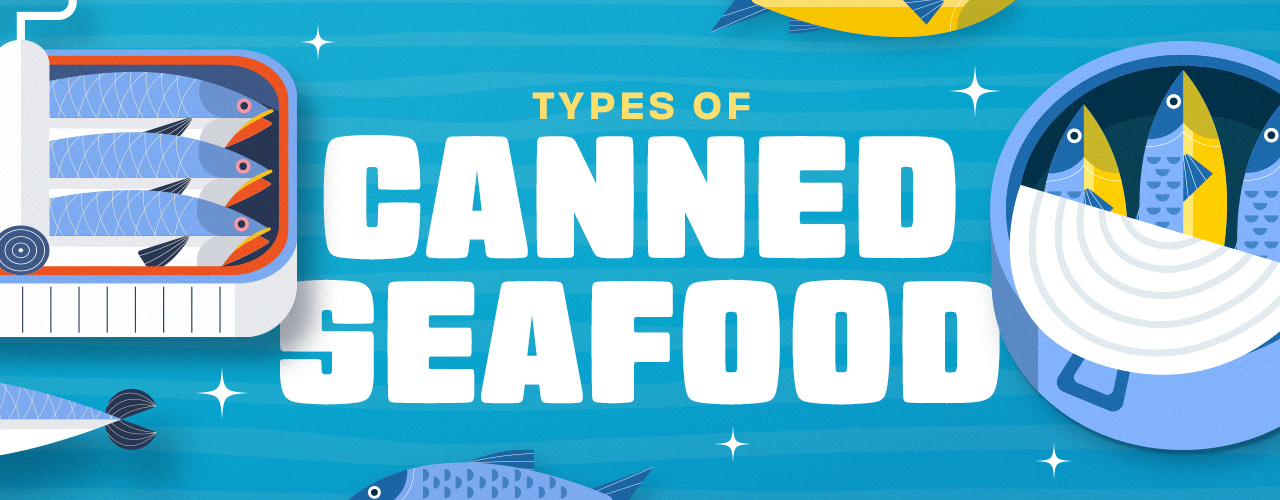
Canned fish is making a big comeback, and we're not just talking about canned tuna. For foodservice operators, canned fish is appealing for a variety of reasons. It's shelf-stable, economical, and can be used creatively to enhance your dishes. When fresh fish and shellfish are hard to source or time-consuming to prepare, canned seafood offers an alternative that's ready to use right out of the can. From sardines to mackerel, we'll introduce you to the different types of canned fish and explain how to use them.
Shop Canned SeafoodWhat Is Canned Fish?
Canned fish has been processed, cooked, and sealed in a can with preservation methods to ensure a longer shelf life. The long expiration date makes it convenient to stock up on canned fish and seafood without worrying about it spoiling quickly. This can help reduce food waste and minimize the need for frequent restocking. Best of all, canned fish is ready to use straight out of the can.
Canned Fish Types
We've made a list of the most popular and accessible types of canned fish you can use for your menu:
1. Sardines

Canned sardines are small, oily fish preserved in a tin can with oil, water, or tomato sauce. These savory fish are about 6 to 11 inches in length and are usually packed whole with bones, skin, and sometimes the head. You may have never tried a sardine, but you’ll probably recognize a sardine can with its easy-to-open pull tab.
What sets sardines apart from the other types of canned fish on our list is their oily composition. These tiny fish pack a lot of nutrients into one small can, including beneficial omega-3 fatty acids. They have a rich, umami flavor and a buttery texture with a less intense fishy taste than some other canned fish.
- What Do Canned Sardines Taste Like? Rich, oily, and slightly salty
- Texture of Canned Sardines: Soft and tender, often with skin and bones
- How to Use Canned Sardines: Sardines on toast, Mediterranean pasta with sardines, and tapenade
- Types of Canned Sardines: European sardines, Pacific sardines
Do Sardines Have Bones?
Yes, sardines are typically sold in cans with their bones intact. These bones are soft and edible, making them safe for consumption. In fact, the bones of sardines are a good source of calcium and other essential minerals, adding nutritional value to the fish.
2. Anchovies

Anchovies are small, silver fish that are typically filleted, salt-cured, and packed in oil or salt to preserve their rich taste. Canned anchovies are known for their instense savory flavor, making them a key ingredient in many Mediterranean and Asian cuisines.
Canned anchovies stand out amongst other small fish because of their bold taste profile. Unlike milder options like canned tuna or salmon, anchovies offer a salty, savory taste that can enhance the flavor of a wide range of dishes. From Caesar salads and pasta dishes to pizza and sauces, anchovies are a go-to ingredient for those looking to add a burst of umami to their cooking.
- What Do Canned Anchovies Taste Like? Intense umami, briny, and salty with a very distinct fishy taste
- Texture of Canned Anchovies: Soft, sometimes meaty but usually delicate
- How to Use Canned Anchovies: Anchovy pizza, Caesar salad dressing, anchovy butter, flavoring pasta, and tapenade
- Types of Canned Anchovies: Mediterranean and Atlantic anchovies
Anchovies vs Sardines
Both anchovies and sardines are well-known types of small canned fish, but they have differences. Sardines are cooked before canning, and anchovies are usually cured in salt. Visually speaking, sardines are larger than anchovies with a light, silver color. Anchovies are the smaller of the two and are dark brown in color. When it comes to taste, anchovies are considered more intense and are often used as a flavor enhancer. Caesar dressing is famously made with anchovies for this reason.
3. Mackerel

Mackerel is a type of canned fish that's medium in size, about 12 to 30 inches long. Because mackerel is larger than small fish like sardines and anchovies, you'll see it packaged in chunks or filets. It does contain bones, but they become softened during the preservation process.
This fatty fish is packed with omega-3 fatty acids, making it a nutritious option for consumers looking to incorporate healthy fats into their diet. One of the defining characteristics of canned mackerel is its flakey texture, which is similar to canned tuna. You can even use canned mackerel in place of tuna in your dishes.
- What Does Canned Mackerel Taste Like? Buttery, rich, and slightly smoky, with a mild sweetness
- Texture of Canned Mackerel: Oily and flaky
- How to Use Canned Mackerel: Mackerel pate, smoked mackerel salads, strongly flavored dishes like curries, stews, or paired with acidic ingredients
- Types of Canned Mackerel: Atlantic, Pacific, and King mackerel
Mackerel vs Sardines
Both mackerel and sardines are types of oily fish packed with good fats, but mackerel contains slightly more omega-3 fatty acids by ounce. Between the two, sardines have a more mineral-like, earthy flavor because they are packed whole. Mackerel is more mild tasting and can be a good introduction to the world of canned fish. It's packaged in flakey chunks or filets which can be used just like canned tuna.
Back to Top4. Herring
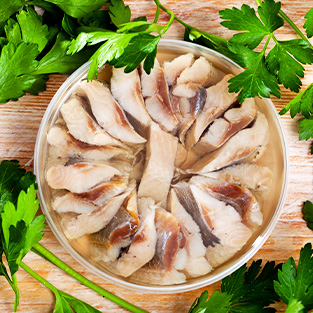
The next type of canned fish on our list is herring, which is known for being smoked, pickled, or brined. It's a common staple food in Scandinavian and German cuisine where it's been consumed for centuries. Preserving herring through pickling and brining was the best way to prepare this fish so that it wouldn't spoil, and this remains a culinary tradition to this day.
Canned herring comes in various types, each offering a unique flavor profile. Pickled herring is a popular choice, marinated in a vinegar-based solution with spices like onions, dill, and mustard seeds. Kippered herring, on the other hand, has been salted and lightly smoked, commonly used in breakfast dishes such as kipper and eggs or kipper sandwiches. Creamed herring is packed in a creamy sauce along with seasonings like onions, herbs, or mustard. Surstromming is fermented herring that is canned and aged for several months before consumption, resulting in a tangy and sour flavor.
- What Does Canned Herring Taste Like? Rich and oily, often pickled or brined for added tang
- Texture of Canned Herring: Firm, but softens when pickled or smoked
- How to Use Canned Herring: Pickled herring, smoked herring on rye, herring in mustard sauce, served with crackers or as part of a charcuterie board
- Types of Canned Herring: Atlantic, Pacific, and Norwegian herring
Herring vs Sardines
Herring and sardines are two different types of fish in the same family. It's common for small fish to be generally referred to as "sardines" and this sometimes happens with herring. Despite the mixup, these are two different fish. Sardines are more common in Mediterranean cuisine and herring is common in Scandinavian cuisine.
5. Tuna

Canned tuna is an American staple food today, a tradition that began during the Second World War, due to its abundance and affordability. Chunk light tuna, often referred to as "skipjack," is a popular choice for salads and sandwiches due to its mild flavor and small, uniform pieces. Albacore tuna, known for its firm texture and white color, is ideal for dishes where appearance and texture are important.
You'll find canned tuna packed in different types of liquid which can affect the flavor and texture. Tuna packed in water is lighter in flavor and calories, which makes it suitable for those on a low-fat diet. On the other hand, tuna packed in oil has more flavor and a softer texture.
- What Does Canned Tuna Taste Like? Albacore is mild and savory, skipjack is rich with pronounced fishiness
- Texture of Canned Tuna: Firm and meaty, or soft and flakey
- How to Use Canned Tuna: Tuna salad, tuna melt sandwich, Nicoise salad, pasta, casseroles
- Types of Canned Tuna: Skipjack, Albacore, Yellowfin, and Bigeye
Is Canned Tuna Cooked?
Yes, canned tuna is cooked and can be eaten straight out of the can. Canning tuna involves cooking the fish at high temperatures to ensure it's safe for consumption. This cooking process not only kills any harmful bacteria but also helps preserve the tuna so that it stays fresh for longer periods.
6. Salmon
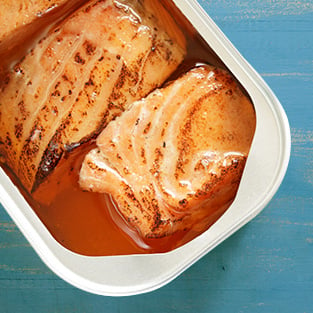
Canned salmon is not as commonly utilized in the United States as canned tuna for several reasons. One key factor is the widespread availability of fresh salmon, which is often deemed to be of higher quality in terms of taste and texture. However, there are specific instances in the foodservice industry where canned salmon may actually be the preferred option. When incorporating salmon into dishes alongside other ingredients, such as in casseroles or salads, it is more suitable and cost-effective to use canned salmon rather than fresh salmon.
There are different types of canned salmon available on the market, including pink salmon, sockeye salmon, and coho salmon. Pink salmon, also known as humpback salmon, is the most commonly canned variety due to its mild flavor and affordable price point. Sockeye salmon, on the other hand, is known for its deep red color and rich flavor, making it a popular choice for those looking for a more flavorful option. Coho salmon, with its medium-firm texture and delicate flavor, is another excellent choice for canned salmon enthusiasts.
- What Does Canned Salmon Taste Like? Mild to medium, with a slightly sweet and rich taste
- Texture of Canned Salmon: Firm, with a noticeable flakiness
- How to Use Canned Salmon: Salmon croquettes, smoked salmon sandwiches, salads, pasta, and as a topping for crackers
- Types of Canned Salmon: Sockeye, Pink, and Chinook
7. Clams
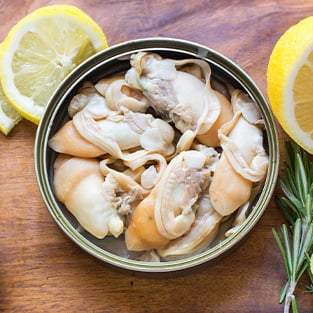
Though technically classified as mollusks, we have included canned clams on our list of canned fish. Fresh clams require strict receiving, cooking, and storing protocols for food safety, but canned clams are safe to use straight out of the can, making them a time-saving option for busy foodservice operations. Canned clams are commonly incorporated into pasta sauces, chowders, seafood stews, and clam dips. Their versatility allows chefs to experiment with different recipes and create unique flavor combinations.
The texture of canned clams can range from tender and succulent to slightly chewy, depending on the specific variety. Whole baby clams often have a firmer texture, making them ideal for dishes where a bit of bite is desired. Chopped or minced clams tend to be softer and can easily blend into sauces, soups, or dips, adding a rich, velvety consistency.
- What Do Canned Clams Taste Like? Mild, briny, and slightly sweet
- Texture of Canned Clams: Firm and chewy
- How to Use Canned Clams: Clam chowder, linguine with clam sauce, paella, seafood casseroles
- Types of Canned Clams: Baby clams, chopped clams, and minced clams
Are Canned Clams Cooked?
Yes, canned clams are cooked during the canning process. Canning involves cooking the clams at high temperatures inside the can to ensure they are safe for consumption. This cooking process not only makes the clams safe to eat but also helps preserve them, making canned clams shelf-stable.
8. Mussels

Canned mussels offer a convenient and flexible seafood choice for commercial kitchens, suitable for a range of dishes. Unlike fresh mussels that need thorough cleaning and prep work, canned mussels come ready to use, saving time for busy chefs.
One popular way to use canned mussels is in seafood pasta dishes, where they add a rich flavor and protein to the meal. They can also be used in soups, stews, and chowders to enhance the seafood taste. Canned mussels can also be incorporated into seafood salads or served as a topping on pizzas or appetizers.
- What Do Canned Mussels Taste Like? Briny and savory
- Texture of Canned Mussels: Tender and slightly chewy
- How to Use Canned Mussels: Stews, soups, salads, pasta, served on toast or crackers
- Types of Canned Mussels: Blue mussel, green-lipped mussel
9. Oysters
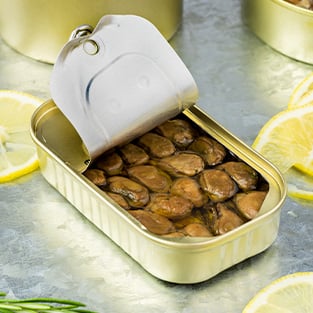
In comparison to fresh oysters, canned oysters have a longer shelf life, making them a convenient pantry staple for commercial kitchens. While fresh oysters are prized for their plump and delicate texture, canned oysters are smaller and more firm. One of the most appealing advantages of incorporating canned oysters into your menu is that they don't need to be shucked and cleaned.
Canned oysters can be used in a wide range of recipes, including soups, stews, chowders, dips, and seafood pastas. Their rich, briny flavor can add depth and complexity to dishes, making them a popular choice for seafood lovers. Canned oysters can also be enjoyed on their own as a snack or appetizer, providing a quick and easy way to enjoy the taste of fresh seafood without the hassle of preparation.
- What Do Canned Oysters Taste Like? Oceanic, salty, and savory
- Texture of Canned Oysters: Dense and chewy
- How to Use Canned Oysters: Seafood stews, chowders, pasta dishes, stuffing, breaded and fried
- Types of Canned Oysters: Pacific and Eastern oysters
10. Crab
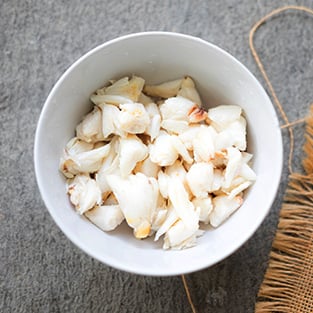
Canned crab is a convenient and budget-friendly way to incorporate crab meat into your menu. It's prepared by cooking the crab, removing the meat from the shell, and packaging it into cans. This allows for easy access to crab meat without the need for immediate preparation. You can use canned crab to make soups, salads, and dips. The texture and chunk size of the crab meat you select will determine how it can be best utilized in your culinary creations.
Most canned crab in the US is sourced from a type of crab called the blue crab. There are three main types of canned crab meat available: lump crab meat, claw crab meat, and backfin crab meat. Lump crab meat consists of large, whole pieces of white meat from the body of the crab, making it ideal for premium dishes and presentations. Claw crab meat, on the other hand, is darker in color and has a stronger flavor, perfect for soups, dips, and crab cakes. Backfin crab meat is a mix of lump and the meat around the swimming fins.
- What Does Canned Taste Like? Sweet and delicate, but milder than fresh crab
- Texture of Canned Crab: Soft and flaky
- How to Use Canned Crab: Maryland crab soup, Maryland crab cakes, crab pretzels, crab rangoons
- Types of Canned Crab: Blue crab
How Long Does Refrigerated Canned Crab Meat Last?
If you purchase refrigerated canned crab meat, you must store it in refrigeration until you're ready to use it. Refer to the expiration date on the can, because this can vary by manufacturer. Once opened, use the crab within 2-3 days.
Canned Fish FAQ
If you're still looking for answers, check out these commonly asked questions about canned fish and seafood:
Is Canned Fish Sustainable?
Canned fish can be a sustainable seafood option depending on how it is sourced. When selecting canned fish, consider options that are certified by organizations such as the Marine Stewardship Council (MSC) or the Aquaculture Stewardship Council (ASC) to ensure they come from responsibly managed fisheries or farms. Look for labels that indicate sustainable fishing practices, such as pole and line caught, to help support the long-term health of fish populations and marine ecosystems.
Which Types of Canned Fish Are Low in Mercury?
Generally, smaller fish species like sardines, anchovies, and herring have lower levels of mercury compared to larger predatory fish such as tuna. Opting for these varieties can help minimize the risk of mercury exposure in your commercial kitchen while still offering a flavorful and nutritious ingredient for your dishes.
Does All Canned Fish Contain Bones?
Not all canned fish contain bones. Some types of canned fish, such as tuna and salmon, are typically deboned. However, certain varieties like sardines and anchovies are commonly sold with bones included for added flavor and nutritional benefits. It's important to check the product label or description to determine if the canned fish you are purchasing contains bones.
Does Canned Fish Go Bad?
While many types of canned fish typically have a long shelf life, it is important to check the expiration date on the can before use. Signs that canned fish has gone bad include a foul odor, bulging or dented cans, or visible mold. Proper storage in a cool, dry place can help extend the shelf life of canned fish.
Is Canned Fish Considered a TCS Food?
Yes, canned fish falls under the category of potentially hazardous foods known as Time/Temperature Control for Safety (TCS) foods. Even though canned fish is already cooked, it must be stored and handled properly. To ensure the safety of canned fish, it is crucial to store it at proper temperatures and follow recommended guidelines for handling and consumption.
Back to TopCanned fish offers foodservice establishments a convenient and versatile option for incorporating seafood into their menus. With a long shelf life, easy storage, and a wide variety of options including tuna, salmon, sardines, and anchovies, canned fish is a cost-effective solution that can be used in a variety of menu items.




